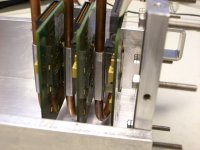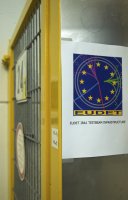 |
 |
|||||||||||||
|
|||||||||||||
|
|||||||||||||
|
Those scientists who develop detectors know a few magic words. Test beam is one, chip is one, DAQ is one. Telescope is another – and a prototype of one of these detector R&D ‘wands’ has just been tested in DESY’s 6-GeV electron beam as part of EUDET’s ‘Joint Research Activity 1’. EUDET is a Europe-funded and Europe-wide project for detector R&D, and one of its core activities is to test beam infrastructures – which include the telescope. It was also the first real test beam since the start of this EUDET activity. This telescope isn't like the one you might have in your backyard for stargazing. It's more like a caliper -- an instrument for measuring the distance between two points -- that comes with a high-precision detector. Its six boards, fitted with silicon sensors, can measure the beam position to a precision of three microns, while another detector is positioned in the middle. The developers of the detector in the middle can then compare their data with that from the telescope. “This will be very important for any pixel detector for the ILC,” says Ingrid-Maria Gregor, who runs the telescope project at DESY. "It tells you whether your pixel detector works. If your data is different from the telescope's, something must be wrong.” The telescope is truly European. The chips come from France, the readout system from Italy, the data acquisition software from Switzerland, the trigger from the UK and the mechanical parts (and the test beam) from Germany. In its first configuration, Gregor and her team tested only three boards to check whether chips and data acquisition software worked. Good news: they did! “We saw tracks within one day,” says Gregor. “We also used the trigger logic for the very first time and it worked immediately.” The mechanical structure and the cooling system need more work, but the team will improve them by the time six boards will be tested in the CERN test beam in September. During that test, the device will hold its first 'client', the DEPFET pixel chip that is being developed at the MPI Munich and the Bonn University in Germany. After all these tests have been done and both the mechanical and the detector part of the prototype telescope are well understood, the final one will be ready for use next year. It will have new chips with a digital readout that will provide even faster data. -- Barbara Warmbein |
|||||||||||||
| © International Linear Collider |

